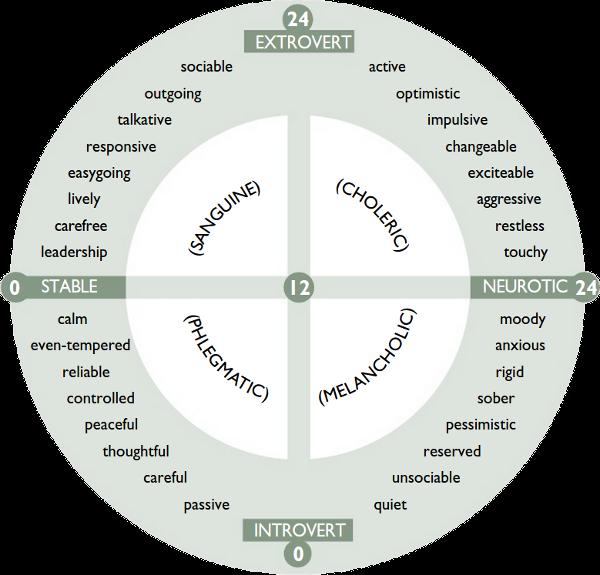Abouttheauthor
HansJ.Eysenck:Eysenck(1916-1997),Britishpsychologist,mainlyengagedinresearchonpersonality,intelligence,behaviorgeneticsandbehaviortheory.Headvocatedlookingatpsychologyfromtheperspectiveofnaturalscience,andtreatingpeopleasabiologicalandsocialorganism.Inthestudyofpersonalityissues,Eysenckusedfactoranalysistoputforwardthetheoryofneuroticism,introversion-extroversionandthethree-dimensionalcharacteristicsofpsychoticism.
Introductiontothequestionnaire
Eysenck'spersonalitytheory(Eysenck'spersonalitytheory)BritishpsychologistH.J.Eysenck’spersonalitytheoryisbasedonthetheoryofthehierarchyofpersonalitystructureandthetheoryofthree-dimensionalpersonalitytypes.Hebelievesthatpersonalityisahierarchicalstructurecomposedofbehaviorsandbehaviorgroupsorganicallyorganized.Atthelowestlevelarecountlessspecificreactions,specificbehaviorsthatcanbedirectlyobserved.Thehigherlevelisthehabitualresponse,whichisthebehavioraltendencyoftheconcreteresponsetobefixedbyrepetition.Thenextlevelistraits,whichareanorganiccombinationofhabitualreactions,suchasanxietyandstubbornness.Thehighestlevelisthetype,whichisanorganiccombinationofagroupofrelatedtraits.Ithashighlygeneralizedcharacteristicsandhasawiderangeofinfluencesonhumanbehavior.Hedeterminedthethreebasicdimensionsofpersonalitytypesthroughfactoranalysisandresearchonpersonalityquestionnairedata.Accordingtotheextraversiondimension,personalitycanbedividedintoextraversiontypeandintroversiontype;personalitycanbedividedintoemotionaltypeandstabletypeaccordingtoemotionalstability;personalitycanbedividedintomentaldisordertypeandmentalintegrationtypeaccordingtopsychopathictendency.
BecauseEPQhashighreliabilityandvalidity,itsmeasuredresultscanbeconfirmedbyavarietyofexperimentalpsychologystudiesatthesametime,soitisalsothebasisforverifyingthetheoryofpersonalitydimensions.TheEysencktestinChinawasrevisedbyChenZhonggengin1981.
Specificmeaning
TheEysenckPersonalityQuestionnaire(EPQ)wascompiledbyProfessorEysenckoftheDepartmentofPsychologyandInstituteofPsychiatry,UniversityofLondon,UK.Hecollectedalargenumberofrelevantnon-cognitivecharacteristics,andsummarizedthreeorthogonaldimensionsthroughfactoranalysis,thusproposingthreebasicfactorsthatdeterminepersonality:introversionandextroversion(E),neuroticism(alsoknownasemotionality).)(N)andmentality(alsoknownasstubbornnessandpragmatism)(P).People'sdifferenttendenciesanddifferentlevelsofperformanceinthesethreeaspectsconstitutedifferentpersonalitycharacteristics.TheEysenckPersonalityQuestionnaireiscurrentlyoneofthemostwidelyusedquestionnairesinthefieldsofmedicine,justice,education,andpsychologicalcounseling.
Thespecificmeaningsofeachscaleareasfollows:
Introvertedandextroverted
Highscoresindicateapersonisextraverted,whichmaybegoodcommunication,thirstandadventurous,emotionalpronetoimpulsivity.Alowscoreindicatesanintrovertedpersonality.Itmaybequietandintrospective.Exceptforclosefriends,itisquietandindifferenttoordinarypeople,doesnotlikestimulation,prefersanorderlylifestyle,andismoreemotionallystable.
Neuroticism
Itreflectsnormalbehaviorandhasnothingtodowithdisease.Ahighscoremaybeanxious,worried,oftendepressed,worried,andhaveastrongemotionalreactionthatleadstounreasonablebehavior.
Psychosis
Itdoesnotimplypsychosis,itexistsineveryone,butthedegreeisdifferent.Butifsomeoneshowsobviousdegree,itiseasytodevelopintoabnormalbehavior.Ahighscoremaybeloneliness,indifferenttoothers,difficultyinadaptingtotheexternalenvironment,inhumane,insensitive,unfriendlytoothers,likeprovocativeanddisturbing,liketodostrangethings,andignoredanger.
Concealment
Measurethesubject’sconcealment,pretenseorself-concealment,ormeasurethelevelofsocialnaivetyandnaivety.Lisrelatedtothefunctionsofotherscales,butititselfrepresentsastablepersonalityfunction.

★Adultscoringfor88questions:(+)meanspositivescoring,thatis,onepointwillbeaddedforanswering"yes",andnopointswillbeaddedforanswering"no";(-)Forreversescoring,nopointswillbeaddedforanswering"yes",andonepointforanswering"no"
Escale(21questions):(+):1510131417253337414953556165718084
(-):212945
Pscale(23questions):(-):269111822384256627288
(+):2630344650666875768185
Nscale(24questions):(+):3712151923273135394347
515759636769737477788286
(-):None
Lscale(20questions):(+):2032365887
(-):4816242840444852546064707983
Resultexplanation
Accordingtothetotalscore(coarsescore)obtainedbythetesteeoneachscale,convertthestandardscoreTscore(T=50+10*(XM)/SD)accordingtothenorm,andthenanalyzeitPersonalitycharacteristicsofthesubjects.TheTscoreofeachscaleisbetween43.3to56.7pointsasintermediatetype,Tscorebetween38.5to43.3pointsor56.7to61.5pointsisatendencytype,andTscoresbelow38.5pointsor61.5pointsormorearetypical.
PersonalityTheory
Eysenck’sPersonalityTheory(Eysenck’sPersonalityTheo-ry)HJEysenckstartsfromthetraittheoryandusesfactoranalysismethodstocomparewithtraditionalexperimentalpsychologymethods.Combiningwithlong-termresearchonpersonalityissues,andturningtheresearchinterestfromtraitstodimensions,heestablishedhisownpersonalitytheory.
Eysenckopposedtheabstractionofthedefinitionofpersonality.Inhisbook"TheDimensionsofPersonality"(1947),hepointedoutthat"personalityisthesumofthepatternsofbehavioractuallyexhibitedbyalivingbody."Eysenckbelievesthatthesumofthisbehaviorpatternincludesfourmainaspects:cognition(intelligence),intention(character),emotion(temperament)andbody(physique).Later,heemphasizedthestabilityanddurabilityofpersonality.
PersonalityDimension
Eysenckinheritedtheworkofpreviousexperimentalpsychologists.Throughthefactoranalysisofalargenumberofhumantraitsdataobtainedfromexperiments,questionnairesandobservations,thein-depthStudythedimensionsofpersonality.Hebelievesthatthestudyofpersonalitytraitsmaysometimesbeambiguous,andonlythestudyofpersonalitydimensionscanmakeitclear.Hepointedoutthatdimensionrepresentsacontinuousscale.Everyonecanbemeasuredinthespecificpositionoccupiedbythiscontinuousscale,thatis,howmucheachpersonhasacertaincharacteristicrepresentedbythedimension.Inthe19thcentury,psychologistshaveproposedtheprototypeofpersonalitydiagrams.Theybelievethatpersonalitycanbedescribedintworight-angledimensions.AccordingtothehypothesisofGermanpsychologistW.Wundt,onedimensionisthetransitionfromstrongemotionalitytoweakemotionality,andtheotherdimensionisthetransitionfromvariabilitytoinvariance.Eysenckputsforwardfivedimensionsofextroversion,neuroticism,mentality,intelligence,andconservative-radicalism,butbelievesthatextroversion,neuroticismandpsychosisarethethreebasicdimensionsofpersonality.
Thefirstpersonwhodidresearchontheconceptofexo-introversionwastheAustrianpsychiatristO.Gross.Later,intheworksofSwisspsychologistC.G.Jung,theconceptofexo-introversionwasintroducedintopersonalityresearch.Later,manyscholarsdidalotofpracticalresearchonexternal-internaldecentpeople.Eysenck'sconceptofexo-introversion,inadditiontoitsowngeneralmeaning,isalsorelatedtotheprocessofexcitementandinhibitionofthenervoussystem.Theexcitementprocesscanfacilitatetheongoingsense,cognitionandactivity;theinhibitionprocesscaninterferewithoraffecttheongoingsense,cognitionandactivityoftheorganism.Hefoundthattheexcitementprocessofhighlyextravertedpeopleoccursslowly,withweakintensity,andshortduration,whiletheinhibitionprocessoccursquickly,withstrongintensity,andlastsforalongtime.Suchpeoplearedifficulttoformaconditionedreflex.Peoplewithhighintroversionhaverapidexcitementprocess,strongintensity,andlongduration,whileinhibitionprocessoccursslowly,weakly,andlastsforashorttime.Suchpeoplearepronetoconditionedreflex.In1976,Revellandothersmadeastudyontheeffectofwork.Theyinferredthattheintrovertedpeoplealreadyhaveahighlevelofexcitementinthecerebralcortexundernormalconditions.Iftheirexcitementlevelisfurtherincreased,thentheworkeffectofthesubjectswillbereduced;theextravertedpeoplehavearelativelyhighlevelofexcitementinthecerebralcortexundernormalconditions.Lower,iftheyincreasetheirlevelofexcitement,itwillimprovetheworkeffectofthesubjects.TheiractualresearchresultsconfirmedtheaboveinferencesandsupportedEysenck'spointofview.
AfterEysenck’sresearchonemotionality,self-strength,anxiety(includingdrive),etc.,itwasfoundthattheyareallthesame.Hecalledthisdimensionneuroticism.Inhislanguage,neuroticismisnotnecessarilyrelatedtomentalillness.Eysenckpointedoutthatemotionallyunstablepeoplearemoodyandeasilyagitated;emotionally(neurotic)stablepeoplereactslowlyandmildly,andeasilyreturntocalm.Hefurtherpointedoutthatemotional(neurotic)isrelatedtothefunctionoftheautonomicnervoussystem,especiallythesympatheticnervoussystem.Eysenckbelievesthatthetwodimensionsofexo-introversionandneuroticismcanbeusedtoexpresstheneurosisofthenormalpersonalityandthepsychopathicpersonality.
Eysenckbelievesthatpsychoticismisindependentofneuroticism.Itrepresentsacharacteristicofstubbornness,stubbornness,brutality,andstone-heartedness,anddoesnotalludetomentalillness.Studieshaveshownthatpsychosiscanalsobeexpressedintermsofdimensions,transitioningfromthenormalrangetotheextremeabnormalend.Itexistsinallpeople,buttovaryingdegrees.Thosewithhighscoresarecharacterizedbyloneliness,carelessness,cold-heartedness,lackofemotionandempathy,hostilitytowardsothers,andstrongaggressiveness.Lowscorersarecharacterizedbygentlenessandkindness.Iftheindividual'spsychosisshowsasignificantdegree,itiseasytocauseabnormalbehavior.Eysenckbelievesthatpsychoticismandneuroticismtogethercanrepresentvariousneurosesandvariousmentalillnesses.
Eysenckbelievesthatexperimentalstudiesonthetwodimensionsofextroversionandneuroticismalmostcompletelyagreethatthesetwofactorsareinastrikingandstablepositioninthepersonalitymeasurementdescriptionsystem.Hetookextra-introversionandneuroticismastwomutuallyperpendicularpersonalitydimensions,withextra-introversionasthelatitude,andneuroticismasthepath(expressedastheendofemotionalstabilityandtheendofemotionalinstability),anddrewadiagramofthehumanpersonalitystructure(seefigure1).Inthetwo-dimensionalspaceofFigure1,Eysenckorganizedthe32basicpersonalitytraitsthathebelievedtobebasic,andcorrespondedtothefourancienttemperamenttypes.Thisdiagramofpersonalitystructureisacceptedbymanypsychologists.Fromthepicture,itisnotonlypossibletoseetheeightpersonalitytraitsincludedinthefourtypesofpersonality(stableextraversion,stableintroversion,unstableextraversionandunstableintroversion),butalsoaccordingtoanindividualForthetraitswithhighscores,lookatthepicturetofindoutthepersonalitytypetowhichtheybelong,orpredictthespecificpersonalityproblemsthatmayoccurinacertainbodyfromthecombinationofdimensions.
TheEysenckPersonalityQuestionnaire(EPQ)wasdevelopedin1975basedonthreepersonalitydimensions:extra-introversion,neuroticismandpsychoticism.ItisformedbyseveralpersonalityscalescompiledbyEysenckearly.EPQisaself-reportingscale.Ithastwoforms:adults(90itemsintotal)andjuveniles(81itemsintotal).Eachincludesfourscales:E-Extra-Introversion;N-Neuroticism;P-Psychotropism;L-Falsificationorself-concealment(i.e.validityscale).Becausethequestionnairehashighreliabilityandvalidity,theresultsmeasuredbyitcanbeconfirmedbyavarietyofexperimentalpsychologystudiesatthesametime,soitisalsothetheoreticalbasisforverifyingthepersonalitydimension.
Hypothesis
Eysenckalsousesfactoranalysismethodsforalargenumberofhumantraits,andputsforwardauniquepersonalitystructurehierarchytheory.ThegeneraldiagramofthistheoryisshowninFigure2.ItcanbeseenfromFigure2thatEysenckdividesthepersonalitystructureintofourlevels:type,trait,habitualresponse,andspecialresponse.Thelowestlevelofspecialresponseisanindividual'sresponsetoanexperimentaltestorsomeofthemostbasic"individualresponses"(suchasthesimplesteverymove)shownindailylife.Itisanerrorfactor,andaboveitisahabitualresponse.Levels,suchasrepeatedexperimentsorreappearanceoflifesituations,apersonwillrespondinasimilarway,whichisaspecialfactor.Traitlevelisanindividual'spersonalitytraitsconstitutedbyaperson'shabitualresponse,whichisagroupfactor.Thetoptypelevelisthetypedisplayedbasedontheinterrelationshipofpersonalitytraits(forexample,theextravertedtypecomposedofpersonalitytraitssuchassociality,impulsivity,activity,liveliness,excitement,etc.,consistsofpersistence,rigidity,etc.,Subjectivity,shame,susceptibilityandotherpersonalitytraitsconstitutetheintrovertedtype),isageneralfactor.
Impact
Eysenck’sresearchonpersonalityshiftedfrompersonalitytraitstopersonalitydimensions,andproposedthreebasicdimensionsofpersonality.Thisisnotonlyconfirmedbymanyexperimentsinthelaboratory,butalsocorroboratedbymathematicalstatisticsandbehavioralobservations.Itisvaluedbypsychologistsinvariouscountriesandhasbeenwidelyusedinthefieldsofmedicine,educationandjustice.TheEysenckPersonalityQuestionnaire(EPQ)isamoreversatilepersonalityscale,whichhasbeentranslatedorrevisedbysomecountries.TheEysencktestinChinawasrevisedbyChenZhonggengequalto1981.Eysenck’spersonalityresearchisnotlikemanyAmericanpsychologistswhoareengagedinorfocusedontraitlevels,butfocusesontypes.Hebelievesthattraitsarethecollectionofobservedindividualbehaviortendencies,andtypeisthecollectionofobservedtraits.Heregardspersonalitytypesastheorganizationofcertaintraits.Thepersonalitytheoryheputforwardismainlyatypeofhierarchicalnature.Thelevelofeachtypestructureisclear,sopersonalitycanbedecomposedintowell-documentedandcountableelements.Thisissomethingthatpsychologistshavebeendiscussingformanyyearsbutaredifficulttodetermine.ManypsychologistsbelievethatEysencksolvestherelationshipbetweentraitsandtypesquitewell.Inthediscussionofthelevelofhistypestructure,itshowsthathispersonalityviewpointdoesnotexcludetheroleofenvironment,butthebiologicaltendencyofpersonalityisstillthemainaspectofhistheory.
Questionnaireapplication
TheEysenckPersonalityQuestionnaireisamethodformeasuringpersonalityintheDepartmentofPsychologyandInstituteofPsychiatry,UniversityofLondon,UK.Thisquestionnaireisdevelopedafterseveralpreviousquestionnaires.Then,therevisedquestionnaireincluded88items,allowingthesubjectstoanswerwhetherbasedontheirownsituation,andthenregisteringthescoresaccordingtothescoringstandardtomeasurethethreedegreesofpersonalitystructure,namely,introversion,psychoticism,andneuroticism.
Eysenck’sthreepersonalitieshavenotonlyundergonemanyanalysesofmathematicalstatisticsandbehavioralobservations,butalsohavebeeninvestigatedbyvariouspsychologicalexperimentsinthelaboratory.Theyarewidelyusedinmedicine,justice,andIneducationandotherfields,itissuitableforallkindsofpeopletotest.
